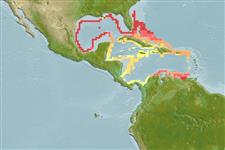Actinopterygii (ray-finned fishes) >
Gadiformes (Cods) >
Merlucciidae (Merluccid hakes) > Steindachneriinae
Etymology: Steindachneria: Because of Franz Steindachner, Austrian ichthyiologist 1831-1819 (Ref. 45335). More on author: Goode, Bean.
Environment / Climate / Range
Ecology
Marine; bathydemersal; depth range 400 - 500 m (Ref. 1371), usually 400 - 500 m (Ref. 1371). Deep-water, preferred ?; 31°N - 8°N, 98°W - 63°W (Ref. 1371)
Western Atlantic: Florida, USA and northern Gulf of Mexico through Central America to Venezuela.
Size / Weight / Age
Maturity: Lm ? range ? - ? cm
Max length : 30.0 cm TL male/unsexed; (Ref. 26340)
Dorsal
spines
(total): 1;
Anal
spines: 0;
Anal
soft rays: 123 - 125. Body long, compressed, tapering to a fine point posteriorly; anus situated between pelvic fins widely separated from the urogenital opening situated anterior to anal fin origin. A striated light organ is present on the ventral half of the body and on the sides of the head. Pyloric caeca absent. First pelvic fin ray long, filamentous, reaching to anus when depressed. Color is silvery, the dorsal portions slightly brownish, purplish ventrally; oral cavity darker.
Inhabits the outer shelf and upper slopes, on soft bottoms.
Life cycle and mating behavior
Maturity | Reproduction | Spawning | Eggs | Fecundity | Larvae
Cohen, D.M., T. Inada, T. Iwamoto and N. Scialabba, 1990. FAO species catalogue. Vol. 10. Gadiform fishes of the world (Order Gadiformes). An annotated and illustrated catalogue of cods, hakes, grenadiers and other gadiform fishes known to date. FAO Fish. Synop. 125(10). Rome: FAO. 442 p. (Ref. 1371)
IUCN Red List Status (Ref. 115185)
CITES (Ref. 94142)
Not Evaluated
Threat to humans
Harmless
Human uses
Fisheries: of no interest
More information
ReferencesAquacultureAquaculture profileStrainsGeneticsAllele frequenciesHeritabilityDiseasesProcessingMass conversion
Tools
Special reports
Download XML
Internet sources
